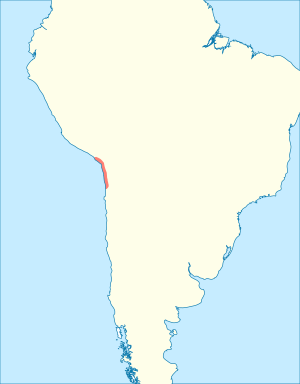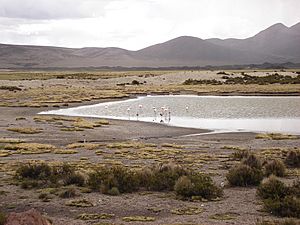Chinchorro culture facts for kids

Where the Chinchorro people lived
|
|
| Geographical range | Atacama Desert |
|---|---|
| Period | Preceramic |
| Dates | c. 7000 - 1500 BCE |
| Preceded by | Monte Verde |
| Followed by | Wankarani |

The Chinchorro culture was a group of people who lived in South America a very long time ago, from about 7,000 to 1,500 BCE. This means they lived before people started using pottery. They were skilled fishermen who stayed in one place, living along the Pacific coast in what is now northern Chile and southern Peru. Fresh water in this dry desert area helped them settle there.
The Chinchorro people are most famous for their amazing mummification practices. They created the oldest mummies in the world! Later on, around 4,000 years ago, they started to learn about agriculture from people living in the high mountains, called the Andean Plateau. Much later, a big empire called the Tiwanaku Empire also influenced them.
In 2021, the Chinchorro culture was added to the World Heritage List. This means their sites are very important and protected globally.
Contents
Who Were the Chinchorro People?
The Chinchorro culture gets its name from Chinchorro Beach (Playa Chinchorro) near Arica, Chile. This is where the first mummies were found.
Where Did They Live?
The Chinchorro people lived along the very dry coast of the Atacama Desert. Their land stretched from Ilo in southern Peru down to Antofagasta in northern Chile. However, their main home seemed to be around the Chilean Arica-Camarones area. This area is between the coastal towns of Arica and Caleta Camarones. Many old sites where they lived have been found around Arica and Caleta Camarones.
What Was Their Daily Life Like?
The Chinchorro people were truly expert fishermen. They created many clever tools for fishing. They used fishing hooks made from shells and cactus spines. They also made stone weights for their fishing nets, which were woven from strong fabrics. They were also very good at weaving baskets and mats.
Most Chinchorro sites are found right on the coast. But some are also found a bit inland and in the nearby highlands. Their main food came from the sea. They ate a lot of fish, shellfish, and sea mammals. Archaeologists have found large piles of ancient shells and trash, called middens, where they lived. Studies of their hair and bones show that about 90 percent of their food came from the ocean. The other 10 percent came from land animals and plants.
The main site where the Chinchorro culture was first studied is in Arica, Chile. A German archaeologist named Max Uhle discovered it in the early 1900s.
Important Places They Lived
Many very old archaeological sites have been found along this coast. In Peru, places like Quebrada Tacahuay and Quebrada Jaguay have been studied. Further south in Chile, there are sites like the Ring site and Quebrada Los Burros. These places are from very, very old times, around 11,000 to 9,000 BCE. Inland in Chile, there are also the sites of Achas and Las Conchas, Chile.
Quebrada Jaguay is the oldest of these sites, dating back to 11,000 BCE. Quebrada Tacahuay, which is a bit further south, is a little younger. Some experts believe the Chinchorro culture grew out of these earlier settlements. The site of Achas is where the very first Chinchorro mummy, known as the Acha man, was found.
Another important site nearby is Monte Verde in Chile. It's now believed to be even older, possibly from as far back as 16,500 BCE.
The Famous Chinchorro Mummies

The Chinchorro mummies are incredibly old, dating back 9,000 years (7,000 BCE). This makes them much older than the famous mummies of ancient Egypt! Scientists have even been able to get some DNA from them. The Chinchorro culture lasted for thousands of years, and their mummification methods changed over time. The culture ended around 1,500 BCE.
Who Studied the Mummies?
Dr. Bernardo Arriaza is a Chilean scientist who has taught us a lot about the Chinchorro people. In 1984, he published his first study about them. Later, in 1994, he created a way to classify the Chinchorro mummies. This system is still used by scientists and others today. In 1995, he wrote an important article for National Geographic Magazine about the Chinchorro mummies. This article was translated into many languages and helped share the story of these ancient mummies around the world. His book, "Beyond Death: The Chinchorro Mummies of Ancient Chile", was published by the Smithsonian Institution Press. It was later translated into Spanish and published in Chile.
Why Did They Make Mummies?
The Chinchorro people mummified almost everyone, no matter their age or social standing. However, important people sometimes had more detailed mummification. Scientists believe that high levels of arsenic (a poisonous substance) in their environment caused many babies to die. This sad situation might have led the Chinchorro people to develop mummification. It was a way for them to deal with their grief and remember their loved ones.
How Did They Make Mummies?
The way they made mummies changed over time. For example, the color of the mummies changed. At first, they were a shiny black color, made with a mineral called manganese. Later, around 2000 BCE, they started making them red.
After someone died, the Chinchorro people would carefully remove the flesh from the body. Then, they would rebuild the body's shape using sticks and clay. They would then preserve the body with special materials, like the black or red pigments. They also created face masks for the mummies. These masks were red or black and had holes for the mouth, nose, and eyes. They were probably made to look like the person's real face. Finally, the mummies were wrapped in mats made of reeds and buried shallowly in the desert sand.
The Oldest Tattoo in the Americas
One Chinchorro male mummy has the oldest tattoo ever found in the Americas! He has a dotted line above his upper lip that looks like a mustache. This tattoo is from around 2300 BCE.
How the Chinchorro Culture Changed
The time between 4,000 and 2,500 years ago was a period of change for the Chinchorro people. This happened in the Azapa Valley near the coast. Around 4,000 years ago, new people from the Altiplano (a high plateau in the Andes mountains) arrived. These new influences led the Chinchorro people to start farming around 3,000 BCE. They also began to use pottery. These later groups no longer mummified their dead.
Archaeologists have studied how early Andean cultures influenced northern Chile. Cultures like the Wankarani culture and the early Pukara culture from the Lake Titicaca area might have played a role. For a while, the Chinchorro people might have lived alongside these new Andean groups along the coast.
See also
 In Spanish: Cultura chinchorro para niños
In Spanish: Cultura chinchorro para niños


